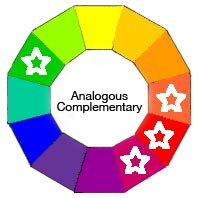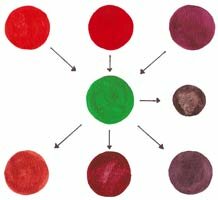Analogous Complementary Color Schemes
 Analogous Complementary Color Schemes use four to five colors on the Color Wheel.
Analogous Complementary Color Schemes use four to five colors on the Color Wheel.
Common sense will tell you this is a combination of an Analogous Color Scheme and a Complementary Color Scheme.
The best time to use this color scheme is when you want closely harmonized, muted colors with a dash of surprising contrast.
Choose any color as your main Mother Color. Then select its Complementary color directly across from it. From there choose two or three colors on either side. A total of three instead of four Analogous Hues work best to avoid over-complicating things.
If you want more than four colors in your color scheme, choose the complementary of either one or both of the other two analogous colors. This will allow you to use either five or six hues all together. It will also give you a wider range of mixtures.
Beware ! Complementary Hues cancel each other out. Analogous Complementary Color Schemes using more than four colors can easy look like one pile of brown mud.
Example of an Analogous Complementary Color Scheme

Here we have selected:
Red/Violet
Red
Red/Orange
Green – the complementary of Red
In this case, Green is the Mother Color and the three Analogous Hues are on the top row. All the Hues in the top row contain Red. This means they are all muted down by Green in very similar ways.
By adding a tiny bit of Green to each pure Hue, you get much more subtle versions, as seen on the bottom row. These new paint colors aren’t altered very much because they’re so close to begin with. But they are far more pleasing and harmonious to the eye than the original tube paint.
The Neutral mixture to the far right is a combination of all four colors.
For a wider range of paint colors and neutrals, add varying amounts of White, Black or Gray to tint, shade or tone down the colors even more.
You also have the option of choosing any of the other three Hues as your Mother Color. This would give you entirely different paint mixtures.
Painting Tips for Analogous Complementary Color Schemes
- Analogous Complementary color schemes always work best if you limit the number of basic hues to four.
- Avoid adding too much of the Complementary or your mixtures will be dull.
- Use different brightness intensities of your mixtures plus the neutral mixture of the four colors. Change the way they look by adding white to lighten for pastels or black to darken to shades and tones.
- Play up your dominant Mother Color in the bright accent areas or focal point. Add a pinch of one other color in your scheme to harmonize.
- Experiment with various balance of mixtures on a piece of paper or in your sketchbooks before you start working on a project. It will give you a better feel of the full range of colors you can achieve.
Check out these Color Schemes
Complementary
Near Complementary
Triad
Complementary Triad
Modified Triad

